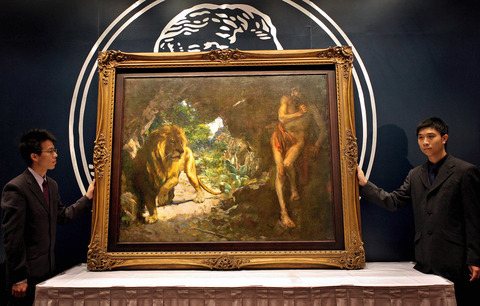An unknown collector forked out HK$53.8 million (US$6.92 million) yesterday for a 1920s painting by a renowned Chinese artist, setting a new record price for Chinese oil paintings.
The price for Slave and Lion by Xu Beihong (
The seller was an unnamed Singapore collector and the auction house declined to provide information about the buyer.

PHOTO: AFP
The price exceeded the previous set by Taiwanese artist Chen Chengbo's (
Another of Xu's oil paintings, Silly Old Man Moves a Mountain, was sold in Beijing five months ago for 30 million yuan (US$3.82 million).
The latest record-breaking paint-ing demonstrated Xu's technique of combining a Western sense of form and Chinese line of drawing.
It was one of the very few works Xu created during his stay in Berlin in the early 1920s, Christie's said.
Slave and Lion, from 1924, depicts a story of a slave and a lion in Europe. The slave, Androcles, who had helped a lion with a thorn in its paw, later ran into the same lion in a cruel human-animal battle staged in a Roman theater. The emperor was moved by the reunion and freed the slave.
The auction yesterday included about 2,500 classical and modern paintings, luxury watches, jewelry and ceramics, most of which came from the region.
Competition was keen for some of the other notable works on offer at the 20th Century Chinese Art Sale. These included Potted Chrysanthemum in a Blue and White Jardiniere by Sanyu (

Shares in Taiwan closed at a new high yesterday, the first trading day of the new year, as contract chipmaker Taiwan Semiconductor Manufacturing Co (TSMC, 台積電) continued to break records amid an artificial intelligence (AI) boom, dealers said. The TAIEX closed up 386.21 points, or 1.33 percent, at 29,349.81, with turnover totaling NT$648.844 billion (US$20.65 billion). “Judging from a stronger Taiwan dollar against the US dollar, I think foreign institutional investors returned from the holidays and brought funds into the local market,” Concord Securities Co (康和證券) analyst Kerry Huang (黃志祺) said. “Foreign investors just rebuilt their positions with TSMC as their top target,

REVENUE PERFORMANCE: Cloud and network products, and electronic components saw strong increases, while smart consumer electronics and computing products fell Hon Hai Precision Industry Co (鴻海精密) yesterday posted 26.51 percent quarterly growth in revenue for last quarter to NT$2.6 trillion (US$82.44 billion), the strongest on record for the period and above expectations, but the company forecast a slight revenue dip this quarter due to seasonal factors. On an annual basis, revenue last quarter grew 22.07 percent, the company said. Analysts on average estimated about NT$2.4 trillion increase. Hon Hai, which assembles servers for Nvidia Corp and iPhones for Apple Inc, is expanding its capacity in the US, adding artificial intelligence (AI) server production in Wisconsin and Texas, where it operates established campuses. This

H200 CHIPS: A source said that Nvidia has asked the Taiwanese company to begin production of additional chips and work is expected to start in the second quarter Nvidia Corp is scrambling to meet demand for its H200 artificial intelligence (AI) chips from Chinese technology companies and has approached contract manufacturer Taiwan Semiconductor Manufacturing Co (TSMC, 台積電) to ramp up production, sources said. Chinese technology companies have placed orders for more than 2 million H200 chips for this year, while Nvidia holds just 700,000 units in stock, two of the people said. The exact additional volume Nvidia intends to order from TSMC remains unclear, they said. A third source said that Nvidia has asked TSMC to begin production of the additional chips and work is expected to start in the second

Garment maker Makalot Industrial Co (聚陽) yesterday reported lower-than-expected fourth-quarter revenue of NT$7.93 billion (US$251.44 million), down 9.48 percent from NT$8.76 billion a year earlier. On a quarterly basis, revenue fell 10.83 percent from NT$8.89 billion, company data showed. The figure was also lower than market expectations of NT$8.05 billion, according to data compiled by Yuanta Securities Investment and Consulting Co (元大投顧), which had projected NT$8.22 billion. Makalot’s revenue this quarter would likely increase by a mid-teens percentage as the industry is entering its high season, Yuanta said. Overall, Makalot’s revenue last year totaled NT$34.43 billion, down 3.08 percent from its record NT$35.52